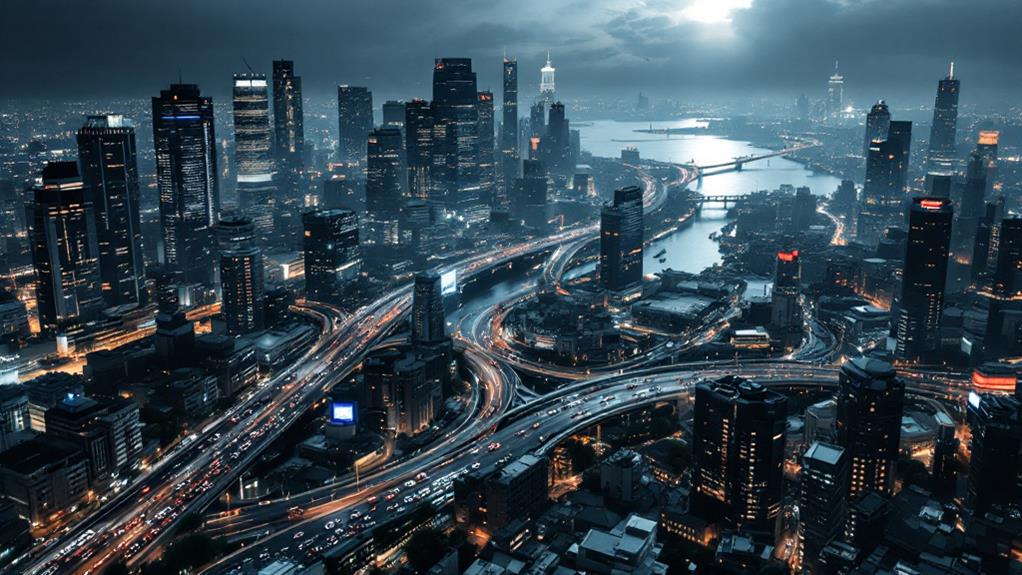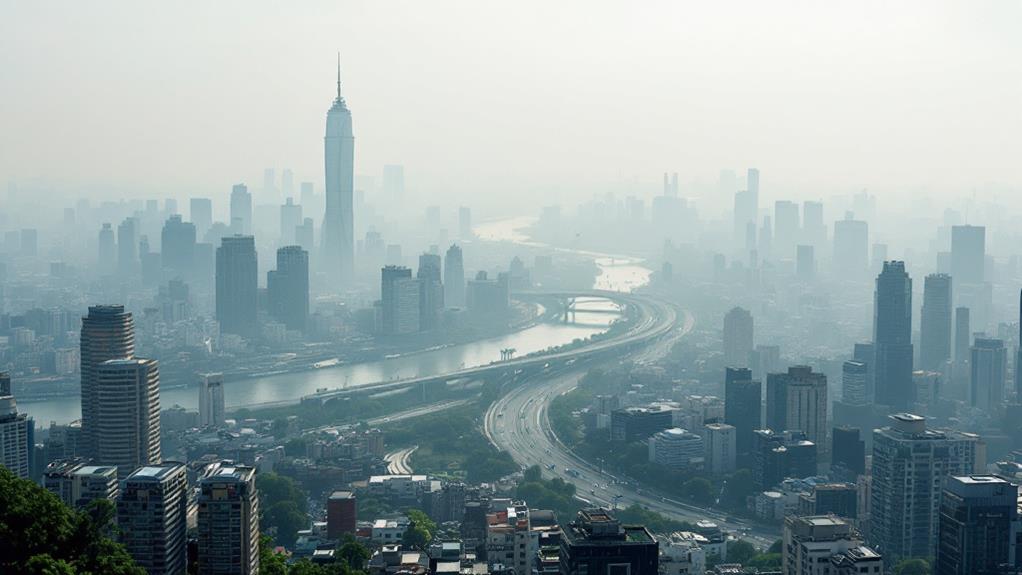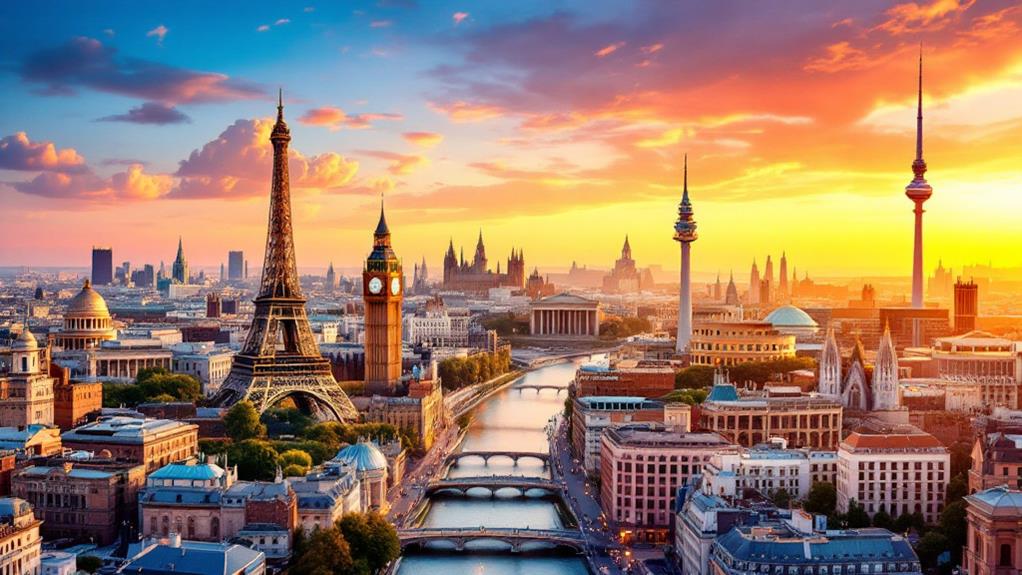What Makes the Largest Cities in the World So Unique?

You'll find the largest cities in the world are unique due to their immense populations and incredible diversity. They're lively economic hubs, contributing considerably to national GDPs and attracting talent and creativity. These cities, like Tokyo and New York, are cultural melting pots with dynamic arts and entertainment scenes. However, their size also brings challenges such as traffic congestion, overcrowding, and pollution. Cutting-edge urban planning and smart technologies are transforming these giant cities, addressing climate change and ensuring sustainable growth. If you're curious about their full range of characteristics and how they're shaping the future, you won't be disappointed.
Defining Megacities
When you're defining megacities, it's vital to take into account both population size and density. Megacities are typically urban agglomerations where the population exceeds 10 million. Some definitions also require a density of at least 2,000 persons per square kilometer. These criteria help distinguish megacities from smaller urban areas. As of 2023, there are different counts of megacities, ranging from 33 to 45, depending on the source. This variation is due to discrepancies in how the boundaries of these urban centers and municipalities are determined.
Take the Greater Tokyo Area, for example. It's recognized as the largest megacity globally, with a staggering population of 37-38 million residents. This megacity exemplifies the complexities of urbanization and the challenges of infrastructure and resource management on such a massive scale. With over half of the global population now living in urban areas, the growth of megacities is a significant trend, particularly in developing regions. As the world population continues to rise, these urban giants will play vital roles in shaping global demographics and require strategic planning to manage their sprawling infrastructures effectively.
Historical Urban Growth
Understanding the evolution of megacities offers valuable insights into historical urban growth. Early cities like Eridu and Uruk in Mesopotamia set the stage around 7500 B.C.E., thanks to rich agricultural land. Fast forward to the primary century B.C.E., and Rome became a powerhouse, surpassing a population of one million. This demonstrated how urbanization could lead to massive agglomerations, a phenomenon that has only accelerated over time.
After World War II, the pace of urban growth skyrocketed. The number of cities with over a million inhabitants jumped from 83 in 1950 to 468 by 2007. This surge was fueled by industrialization and mass migration into cities, enhancing their development. By 2017, megacities—urban areas with populations over 10 million—ballooned from just 2 in 1950 to 37. The shift was particularly pronounced in developing countries.
Colonial influence also played a crucial role in shaping these cities' growth trajectories. Former colonial cities often became economic hubs, driving urbanization as they modernized. The historical layers of industrialization and colonial impact are evident in megacities today, reflecting a complex tapestry of population growth and urban development.
Unique Challenges

Urbanization brings with it a myriad of challenges that megacities must confront head-on. As urban populations swell, cities like Tokyo and Delhi are grappling with severe traffic congestion, leading to lengthy commutes that eat away at productivity and quality of life. The overcrowding you witness in these urban areas results in a staggering number of people living in informal housing or shantytowns, with projections suggesting this could rise to over 2 billion by 2030, especially in Africa and Asia.
Housing shortages exacerbate the situation further. In places like Mexico City, over 30% of the population resides in illegal settlements due to the high demand and skyrocketing costs. Air pollution is a constant battle for cities such as Beijing and São Paulo, where levels often exceed safe limits, putting public health at risk.
Moreover, the infrastructure in many megacities is ill-equipped to handle natural disasters like flooding, as seen in Dhaka. Poor urban planning makes these areas even more vulnerable to the impacts of climate change. As you navigate these urban landscapes, the challenges of balancing growth with sustainability become starkly evident, requiring both groundbreaking solutions and global cooperation.
Cultural and Economic Influence
Megacities wield an immense cultural and economic influence that echoes worldwide. Cities like Tokyo and New York are powerhouses, markedly contributing to global GDP. Tokyo alone makes up about 10% of Japan's economy, showcasing the critical role these metropolitan areas play. As financial capitals, cities like Mumbai and São Paulo drive economic growth by housing multinational corporations and financial institutions. These cities aren't just about numbers; they're lively cultural hubs pulsating with energy and innovation.
Tourism flourishes in cultural hubs such as Paris and Shanghai, where millions flock each year. The allure lies in their diverse offerings—arts, cuisine, and historical landmarks—that captivate and enrich the global cultural landscape. You'll find that the diverse populations in places like Los Angeles and Toronto bring a unique blend of traditions, languages, and cuisines, creating a tapestry of cultures that's both dynamic and inviting.
In cities like New York and London, creativity thrives, fostering innovation and a dynamic environment for artists and entrepreneurs. These lively cultural scenes not only enrich local economies but also influence global trends, setting the stage for future generations to investigate new ideas and possibilities.
Environmental Impacts

Though megacities are hubs of innovation and growth, they considerably impact the environment. You might notice the significant contribution to global air pollution, with places like Beijing and São Paulo suffering from hazardous smog due to vehicle emissions and industrial activity. This pollution not only degrades air quality but also worsens climate change, impacting public health. The urban heat island effect, where city temperatures rise above those of surrounding rural areas, further exacerbates climate issues, making life in megacities even more challenging.
Waste management is another pressing concern. In densely populated areas, inadequate sanitation leads to increased litter and pollution, posing health risks to over a billion people living in urban slums. As rapid urbanization continues, inefficient land use and urban sprawl disrupt local ecosystems, driving up infrastructure costs. This expansion into low-density areas highlights the urgent need for sustainable urban planning.
Moreover, the emission of long-term pollutants from megacities affects local climates and threatens biodiversity. Addressing these challenges requires a commitment to sustainable practices, ensuring that as these cities grow, they do so responsibly, minimizing their environmental footprint and fostering resilient urban environments.
Future Urban Trends
Anticipating future urban trends involves preparing for the rapid growth and transformation of cities worldwide. By 2025, Asia will host at least 30 megacities like Mumbai, Shanghai, and Delhi, underscoring the region's swift urbanization. The global urban population is set to spike from 3.2 billion to nearly 5 billion by 2030, primarily fueled by migration to megacities in developing countries. This surge presents unique urban challenges, including overcrowding and strained infrastructure.
To tackle these issues, cities must adopt groundbreaking infrastructure solutions. These can help alleviate congestion and address inadequate housing, guaranteeing sustainable growth. Climate change is another significant factor. Megacities need robust adaptation strategies to build resilience against environmental impacts. This will protect both infrastructure and vulnerable populations from the adverse effects of climate change.
Gentrification and displacement further complicate urban redevelopment. Rapid growth often displaces low-income communities, raising social equity concerns. Balancing development with inclusivity is essential. As more people migrate to urban centers, cities must prioritize inclusive policies that foster equitable opportunities for all residents. By addressing these challenges proactively, you can guarantee that future urban landscapes remain dynamic, sustainable, and resilient against the pressures of rapid population growth and environmental change.



